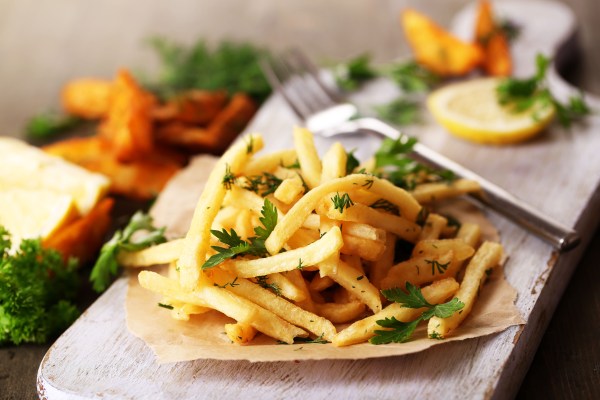
There’s something about French culture, cuisine, history, and the very language itself that’s always felt a little overwhelming to me. I think it has to do with some image I’m projecting onto the French people — this idea that every single one of them can speak eloquently on food, art, and politics, and do so with a cigarette dangling from their lips.
I’m not alone in being intimidated by the French. In Me Talk Pretty One Day, David Sedaris writes:
My fear had nothing to do with actual French people. I didn’t know any actual French people. What scared me was the idea of French people I’d gotten from movies and situation comedies. When someone makes a spectacular ass of himself, it’s always at a French restaurant, never a Japanese or Italian one. The French are people who slap one another with gloves and wear scarves to cover their engorged hickies.
Sedaris nailed it. It’s not real France that scares us, but some mythos we’ve built up over generations. It’s a shame too, because French art, food, and culture are all worth knowing a little something about — even if you don’t want to go full Francophile.
Since today marks Bastille Day, we thought we’d offer a brief explainer of the holiday:
On July 14, 1789, France’s commoners stormed a hulking armory (The Bastille) to gain weapons and set free any political prisoners kept inside. At the time, there were only seven people but hey, a revolution’s gotta start somewhere.
A year later, they picked the 14th to mark Fête de la Fédération and held a parade to celebrate. As with all political holidays, there’s more to it than that, but if you’ve got “storming of Bastille to get ammo and the parade a year later to celebrate unity” you’ll be in good shape.
…And share a few classic French dishes for you to try in celebration.
Complete with a very scientific Degree of Difficulty Rating.
_________________
FOIE GRAS. This is ultra-fatty liver of duck or goose. The bird is fattened before slaughter using a technique called gavage, which is done with a feeding tube, making this a hotly contested issue between chefs and Animal Rights activists. Last spring, California legislature lifted their foie gras ban and some chefs received violent threats.
Degree of Difficulty Rating: 7. Some people don’t like the texture or the off-the-charts richness. Those people are crazy.
SWEETBREADS. Sweetbreads are glands (thymus and pancreas, typically) of animals (usually veal or lamb). You might know them due to the fact that every single chef on the Food Network talks about how amazing they are. If Jeffery Zakarian and Giada De Laurentiis can’t convince you to try something new, who can?
Degree of Difficulty Rating: 6. The very idea of eating glands is a little tough for some people, hence the deceptive name.
DUCK CONFIT. Confit is a style of cooking in which the meat is submerged completely in oil or grease (but at a much lower temperature than a deep fryer). This started as a preservation technique but is now used as a way to ensure that meat retains its moisture, something everyone can get on board with.
Degree of Difficulty Rating: 3. The only thing that might scare you away here is a French word — Americans long ago proved they could enjoy things cooked in pure fat.
ÉCLAIR. The éclair is kind of the “it” dessert of the moment. It’s made with choux pastry — noted for the air pockets that are created when it goes into the oven. Pay attention and you’ll notice highly stylized éclairs popping up on menus, bakeries, and in stand alone éclair shops throughout the country.
Degree of Difficulty Rating: 1. Maybe you’re intimidated about potentially ordering it wrong…but it’s basically a donut.
CROQUE MADAME. The croque monsieur is a grilled ham and cheese sandwich. The croque madame trumps that — it’s got the ham and cheese but also features a fried egg on top. You don’t have to be Escoffier to know that everything is better with a fried egg.
Degree of Difficulty Rating: 2. It’s a cheese sandwich. Even among sandwiches it’s un-intimidating.
PAIN PERDU. Better known as French Toast, this dish is nothing more than the perfect indulgent breakfast and the easiest way in human existence to convince someone that you know how to cook.
Degree of Difficulty Rating: 1. The only thing that could scare you off from ordering this one is not knowing that it’s just French toast — or, as in the case of the Pain Perdu from Social in Costa Mesa, CA (below), if it comes with a piece of seared foie gras on top.
MACARON. These delicate cookies have recently been pushed aside by the food world losing their collective mind about éclairs. Since macarons are basically just egg whites and sugar with buttercream inside, it’s no surprise that they taste good — making this a pretty gentle starter course for anyone slow to warm up to French cuisine.
Degree of Difficulty Rating: 0.5. Look at those delicate little things. How could anything be less scary?

FRENCH ONION SOUP. Beef stock with onions, melted cheese, and bread. Forget “French” food, if you don’t like French Onion Soup you might not like any food.
Degree of Difficulty Rating: 0.01. It’s simple, it has cheese, and the name is in English.
POMMES FRITES. These are French Fries. There, happy Bastille Day! You love french fries.
Degree of Difficulty Rating: 0.0001. Obviously.

ROYALE WITH CHEESE. If nothing else, you can always order a Royale with Cheese.
Degree of Difficulty Rating: No difficulty. Except for your arteries. Your arteries will hate you for this one.






